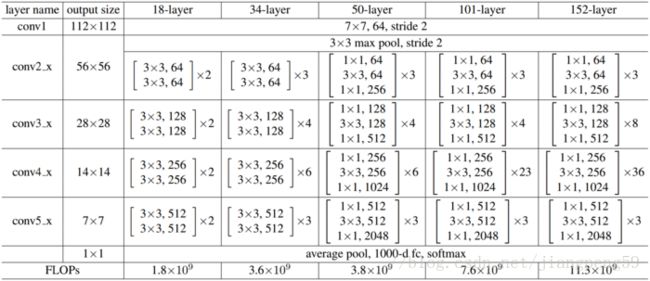pytorch笔记:04)resnet网络&解决输入图像大小问题
因为torchvision对resnet18-resnet152进行了封装实现,因而想跟踪下源码(▽)
首先看张核心的resnet层次结构图(图1),它诠释了resnet18-152是如何搭建的,其中resnet18和resnet34结构类似,而resnet50-resnet152结构类似。下面先看resnet18的源码

resnet18
首先是models.resnet18函数的调用
def resnet18(pretrained=False, **kwargs):
"""Constructs a ResNet-18 model.
Args:
pretrained (bool): If True, returns a model pre-trained on ImageNet
"""
#[2, 2, 2, 2]和结构图[]X2是对应的
model = ResNet(BasicBlock, [2, 2, 2, 2], **kwargs)
if pretrained: #加载模型权重
model.load_state_dict(model_zoo.load_url(model_urls['resnet18']))
return model
这里涉及到了一个BasicBlock类(resnet18和34),这样的一个结构我们称为一个block,因为在block内部的conv都使用了padding,输入的in_img_size和out_img_size都是56x56,在图2右边的shortcut只需要改变输入的channel的大小,输入bloack的输入tensor和输出tensor就可以相加(详细内容)
事实上图2是Bottleneck类(用于resnet50-152,稍后分析),其和BasicBlock差不多,图3为图2的精简版(ps:可以把下图视为为一个box_block,即多个block叠加在一起,x3说明有3个上图一样的结构串起来):
BasicBlock类,可以对比结构图中的resnet18和resnet34,类中expansion =1,其表示box_block中最后一个block的channel比上第一个block的channel,即:
e x p a n s i o n = l a s t _ b l o c k _ c h a n n e l / f i r s t _ b l o c k _ c h a n n e l expansion= last\_block\_channel/first\_block\_channel expansion=last_block_channel/first_block_channel
def conv3x3(in_planes, out_planes, stride=1):
"3x3 convolution with padding"
return nn.Conv2d(in_planes, out_planes, kernel_size=3, stride=stride,
padding=1, bias=False)
class BasicBlock(nn.Module):
expansion = 1
#inplanes其实就是channel,叫法不同
def __init__(self, inplanes, planes, stride=1, downsample=None):
super(BasicBlock, self).__init__()
self.conv1 = conv3x3(inplanes, planes, stride)
self.bn1 = nn.BatchNorm2d(planes)
self.relu = nn.ReLU(inplace=True)
self.conv2 = conv3x3(planes, planes)
self.bn2 = nn.BatchNorm2d(planes)
self.downsample = downsample
self.stride = stride
def forward(self, x):
residual = x
out = self.conv1(x)
out = self.bn1(out)
out = self.relu(out)
out = self.conv2(out)
out = self.bn2(out)
#把shortcut那的channel的维度统一
if self.downsample is not None:
residual = self.downsample(x)
out += residual
out = self.relu(out)
return out
接下来是ResNet类,其和我们通常定义的模型差不多一个__init__()+forward(),代码有点长,我们一步步来分析:
- 参考前面的结构图,所有的resnet的第一个conv层都是一样的,输出channel=64
- 然后到了self.layer1 = self._make_layer(block, 64, layers[0]),这里的layers[0]=2,然后我们进入到_make_layer函数,由于stride=1或当前的输入channel和上一个块的输出channel一样,因而可以直接相加
- self.layer2 = self._make_layer(block, 128, layers[1], stride=2),此时planes=128而self.inplanes=64为上box_block的输出channel,此时channel不一致,需要对输出的x扩维后才能相加,downsample 实现的就是该功能(ps:这里只有box_block中的第一个block需要downsample,为何?请看下图)
- self.layer3 = self._make_layer(block, 256, layers[2], stride=2),此时planes=256而self.inplanes=128为,此时也需要扩维后才能相加,layer4 同理。

图4中下标2,3,4和上面的步骤对应,图中箭头旁数值表示box_block输入或者输出的channel数。
具体看图4-2,上一个box_block的最后一个block输出channel为64(也是下一个box_block的输入channel),而当前的box_block的第一个block的输出为128,在此需要扩维才能相加。然后到了当前box_block的第2个block,其输入channel和输出channel是一致的,因此无需扩维。
也就是说在box_block内部,只需要对第1个block进行扩维,因为在box_block内,第一个block输出channel和剩下的保持一致了。
class ResNet(nn.Module):
def __init__(self, block, layers, num_classes=1000):
self.inplanes = 64
super(ResNet, self).__init__()
self.conv1 = nn.Conv2d(3, 64, kernel_size=7, stride=2, padding=3,
bias=False)
self.bn1 = nn.BatchNorm2d(64)
self.relu = nn.ReLU(inplace=True)
self.maxpool = nn.MaxPool2d(kernel_size=3, stride=2, padding=1)
self.layer1 = self._make_layer(block, 64, layers[0])
self.layer2 = self._make_layer(block, 128, layers[1], stride=2)
self.layer3 = self._make_layer(block, 256, layers[2], stride=2)
self.layer4 = self._make_layer(block, 512, layers[3], stride=2)
self.avgpool = nn.AvgPool2d(7, stride=1)
self.fc = nn.Linear(512 * block.expansion, num_classes)
for m in self.modules():
if isinstance(m, nn.Conv2d):
n = m.kernel_size[0] * m.kernel_size[1] * m.out_channels
m.weight.data.normal_(0, math.sqrt(2. / n))
elif isinstance(m, nn.BatchNorm2d):
m.weight.data.fill_(1)
m.bias.data.zero_()
def _make_layer(self, block, planes, blocks, stride=1):
#downsample 主要用来处理H(x)=F(x)+x中F(x)和xchannel维度不匹配问题
downsample = None
#self.inplanes为上个box_block的输出channel,planes为当前box_block块的输入channel
if stride != 1 or self.inplanes != planes * block.expansion:
downsample = nn.Sequential(
nn.Conv2d(self.inplanes, planes * block.expansion,
kernel_size=1, stride=stride, bias=False),
nn.BatchNorm2d(planes * block.expansion),
)
layers = []
#只在这里传递了stride=2的参数,因而一个box_block中的图片大小只在第一次除以2
layers.append(block(self.inplanes, planes, stride, downsample))
self.inplanes = planes * block.expansion
for i in range(1, blocks):
layers.append(block(self.inplanes, planes))
return nn.Sequential(*layers)
def forward(self, x):
x = self.conv1(x)
x = self.bn1(x)
x = self.relu(x)
x = self.maxpool(x)
x = self.layer1(x)
x = self.layer2(x)
x = self.layer3(x)
x = self.layer4(x)
x = self.avgpool(x)
x = x.view(x.size(0), -1)
x = self.fc(x)
return x
resnet152
resnet152和resnet18差不多,Bottleneck类替换了BasicBlock,[3, 8, 36, 3]也和上面结构图对应。
def resnet152(pretrained=False, **kwargs):
"""Constructs a ResNet-152 model.
Args:
pretrained (bool): If True, returns a model pre-trained on ImageNet
"""
model = ResNet(Bottleneck, [3, 8, 36, 3], **kwargs)
if pretrained:
model.load_state_dict(model_zoo.load_url(model_urls['resnet152']))
return model
Bottleneck类,这里需要注意的是 expansion = 4,前面2个block的channel没有变,最后一个变成了第一个的4倍,具体可看本文的第2个图。
class Bottleneck(nn.Module):
expansion = 4
def __init__(self, inplanes, planes, stride=1, downsample=None):
super(Bottleneck, self).__init__()
self.conv1 = nn.Conv2d(inplanes, planes, kernel_size=1, bias=False)
self.bn1 = nn.BatchNorm2d(planes)
self.conv2 = nn.Conv2d(planes, planes, kernel_size=3, stride=stride,
padding=1, bias=False)
self.bn2 = nn.BatchNorm2d(planes)
self.conv3 = nn.Conv2d(planes, planes * 4, kernel_size=1, bias=False)
self.bn3 = nn.BatchNorm2d(planes * 4)
self.relu = nn.ReLU(inplace=True)
self.downsample = downsample
self.stride = stride
def forward(self, x):
residual = x
out = self.conv1(x)
out = self.bn1(out)
out = self.relu(out)
out = self.conv2(out)
out = self.bn2(out)
out = self.relu(out)
out = self.conv3(out)
out = self.bn3(out)
if self.downsample is not None:
residual = self.downsample(x)
out += residual
out = self.relu(out)
return out
图像输入大小问题:
首先pytorch输入的大小固定为224224,超过这个大小就会报错,比如输入大小256256
RuntimeError: size mismatch, m1: [1 x 8192], m2: [2048 x 1000] at c:\miniconda2\conda-bld\pytorch-cpu_1519449358620\work\torch\lib\th\generic/THTensorMath.c:1434
首先我们看下,resnet在哪些地方改变了输出图像的大小
conv和pool层的输出大小都可以根据下面公式计算得出
H o u t = f l o o r ( ( H i n + 2 ∗ p a d d i n g [ 0 ] − k e r n e l _ s i z e [ 0 ] ) / s t r i d e [ 0 ] ) + 1 H_{out} = floor((H_{in} + 2 * padding[0] - kernel\_size[0]) / stride[0]) + 1 Hout=floor((Hin+2∗padding[0]−kernel_size[0])/stride[0])+1
W o u t = f l o o r ( ( W i n + 2 ∗ p a d d i n g [ 1 ] − k e r n e l _ s i z e [ 1 ] ) / s t r i d e [ 1 ] ) + 1 W_{out} = floor((W_{in} + 2 * padding[1] -kernel\_size[1] ) / stride[1] )+ 1 Wout=floor((Win+2∗padding[1]−kernel_size[1])/stride[1])+1
但是resnet里面的卷积层太多了,就resnet152的height而言,其最后avgpool后的大小为 h o u t = c e i l ( h i n / 32 − 7 + 1 ) h_{out}=ceil( h_{in}/32-7+1) hout=ceil(hin/32−7+1),因此修改源码把图像的height和width传递进去,从而兼容非224的图片大小:
self.avgpool = nn.AvgPool2d(7, stride=1)
f = lambda x:math.ceil(x /32 - 7 + 1)
self.fc = nn.Linear(512 * block.expansion * f(w) * f(h), num_classes) #block.expansion=4
也可以在外面替换跳最后一个fc层,这里的2048即本文图1中resnet152对应的最后layer的输出channel,若是resnet18或resnet34则为512
model_ft = models.resnet152(pretrained=True)
f = lambda x:math.ceil(x /32 - 7 + 1)
model_ft.fc = nn.Linear(f(target_w) * f(target_h) * 2048, nb_classes)
还有另外一种暴力的方法,就是不管卷积层的输出大小,取其平均值做为输出,比如:
self.main = torchvision.models.resnet152(pretrained)
self.main.avgpool = nn.AdaptiveAvgPool2d((1, 1))
第一次研究pytorch,请大神门轻喷
reference:
resnet详细介绍
deeper bottleneck Architectures详细介绍
